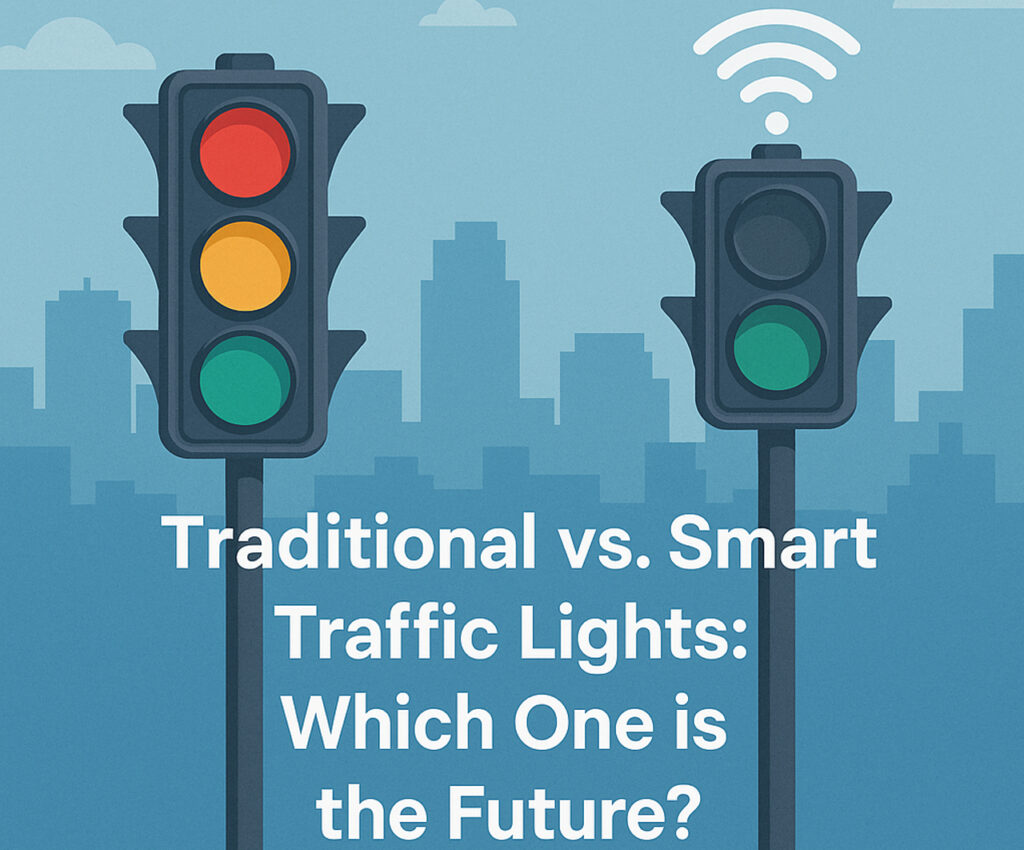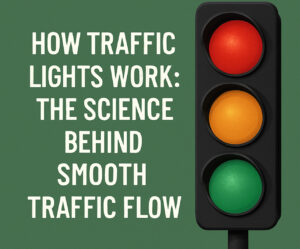Every driver has experienced the frustration of waiting at a red light with no other cars in sight. As cities evolve, so do their approaches to managing traffic signals. From old-school timed systems to Smart Traffic Lights powered by artificial intelligence and real-time data, the battle is on between traditional and intelligent systems. Smart Traffic Lights can detect vehicle presence, adapt to traffic flow, coordinate emergency responses, and even communicate with connected vehicles to optimize light sequences. Whether it’s navigating light traffic or reducing congestion during peak hours, the way we control intersections is changing rapidly. But which system truly represents the future? Know more..
The Basics of Traditional Traffic Lights
Traditional traffic lights operate on fixed timing plans. These systems have been around for over a century and have served their purpose. A controller rotates through red, yellow, and green cycles at preset intervals. It doesn’t care if you’re the only car on the road or if the intersection is packed—the timing remains constant.
While predictable, this method can be inefficient. It’s not uncommon to encounter a traffic signal that stays red for a full cycle despite light traffic in all directions. In many cases, the light traffic light delay results in wasted fuel, time, and increased emissions.
How Smart Traffic Lights Work
Smart traffic lights take a data-driven approach. Using cameras, sensors, radar, and sometimes AI, these systems assess real-time conditions at intersections. If light traffic is detected, the light traffic light timing adjusts accordingly, reducing unnecessary waits.
These smart systems can:
- Prioritize buses and emergency vehicles
- Detect pedestrians and cyclists
- Respond to real-time congestion
- Coordinate with neighboring intersections for traffic flow optimization
At the heart of it all is a responsive algorithm that learns and adapts to conditions. Unlike traditional systems, smart traffic lights offer flexibility.
The Impact on Congestion
One of the biggest selling points of smart traffic systems is congestion reduction. With traditional traffic signals, intersections can become chokepoints. During peak hours, mistimed lights exacerbate gridlock.
Smart systems, however, can dynamically shift green light durations, allowing more vehicles to pass through when demand is high. In light traffic scenarios, smart lights can skip or shorten cycles entirely. This keeps intersections clear and traffic moving.
Data from smart cities shows that implementing AI-driven light traffic light systems can reduce delays by up to 40% and vehicle idling time by over 25%.
Environmental Considerations
When cars sit idle at a traffic signal, they burn fuel and release emissions. Over time, these delays contribute significantly to urban air pollution. In areas with light traffic, the environmental cost of traditional lights becomes harder to justify.
Smart lights offer a solution. By adjusting in real time and avoiding unnecessary idling, cities can cut carbon emissions. Cleaner air and lower fuel consumption are real-world benefits of embracing smarter infrastructure.
Safety and Emergency Response
Smart traffic systems are more than just time savers. They can enhance safety. Many are equipped to detect ambulances and fire trucks, altering signals to clear their path. With traditional a traffic signal, emergency vehicles often get stuck, forced to weave through intersections.
Smart light traffic light systems can also prioritize pedestrian crossings and bicycle lanes, increasing safety for all users.
Maintenance and Cost
You might think that smart lights are more expensive, and they are—at least upfront. Traditional systems are simple, require less tech, and are cheaper to install.
But the long-term picture tells a different story. Smart light traffic light systems reduce congestion, improve fuel economy, and lower accident rates. These outcomes lead to cost savings that more than offset the initial investment.
Plus, remote diagnostics and cloud-based controls mean reduced maintenance visits and quicker fixes.
Integration with Smart Cities
A modern city runs on data. Smart traffic lights are just one piece of a connected urban ecosystem. Integrated systems can share data with:
- Public transportation networks
- Parking management platforms
- Weather and event monitoring services
This kind of synergy is impossible with a traditional traffic signal setup. A smart light traffic light can adapt not just to the number of cars on the road, but to upcoming events, forecasted weather, or even planned protests and parades.
Public Perception and Driver Behavior
It’s not just about tech. People respond differently to different systems. With traditional lights, drivers often grow frustrated when they perceive inefficiency. This can lead to red-light running or risky behavior.
Smart systems, by contrast, are designed to improve flow, which can reduce stress and aggressive driving. When drivers feel the system is “working with them,” compliance improves.
Also, visible sensors and dynamic changes in a traffic signal pattern build trust. People see the system responding in real time, which reinforces the idea that it’s designed to help them.
Challenges with Smart Traffic Lights
No system is perfect. Smart lights require robust data infrastructure and regular updates. They can be vulnerable to cyber threats if not properly secured. Sensor failures or bad weather can also interfere with detection systems.
Still, these issues are manageable. As technology evolves, so do safeguards and redundancies. Modern light traffic light networks include fail-safes that ensure operations continue even during outages or system failures.
The Future is Adaptive
So, where are we headed? The future is clearly leaning toward smart systems. As vehicles become more connected, a traffic signal will become part of a communication network. Your car will “talk” to the signal, and the signal will respond in milliseconds.
Autonomous vehicles, ride-sharing platforms, and delivery drones all require flexible, responsive infrastructure. Traditional light traffic methods simply can’t keep up with this pace of change.
Even in suburban areas with light traffic, adaptive systems offer value. They reduce energy use, improve flow, and make streets safer for everyone.
Case Study: Smart Lights in Action
Take the city of Barcelona, for instance. They implemented a smart light traffic light system in high-density areas. Using a combination of sensors and predictive analytics, the city reduced travel times by 21%, cut emissions by 25%, and improved bus punctuality by over 30%.
Traditional a traffic signal setup could never have achieved those numbers. It’s a clear win for adaptive systems.
Final Thoughts
Smart traffic lights represent more than a technological upgrade. They reflect a new philosophy in urban planning: dynamic, responsive, and human-centered. While traditional systems still have a place in some environments, they are quickly becoming outdated.
From managing light traffic efficiently to adjusting the light traffic light based on real-world needs, smart systems are proving to be safer, greener, and more cost-effective.
So, is it even a contest? Not really. When it comes to choosing between traditional and smart traffic systems, the future clearly belongs to those that adapt.





